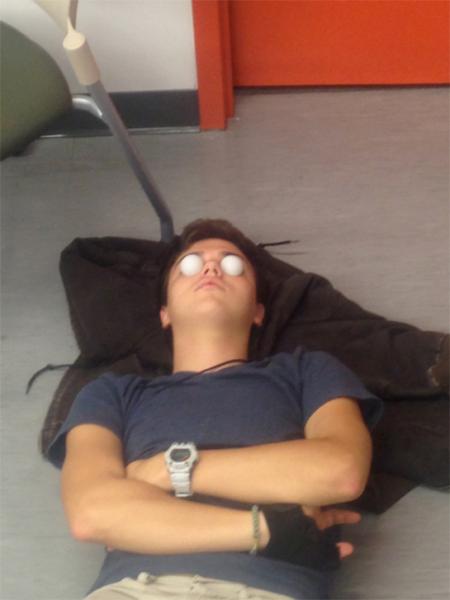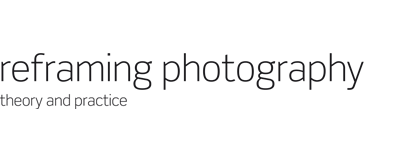Exploring Human Vision
Many visual aids and devices, such as photographic cameras, are based on human optics. So close is the relationship between human vision and photographic seeing that we tend to forget there is a difference. However, the constant fluctuation of the eyes as they scan, seek and trail after visual phenomena is quite different from the experience of seeing through a photographic camera, and vastly different from the representation of that vision in a flat, still photographic image. Recognizing the complex physical and cultural dynamics caught up in the act of looking allows us recognize the eyes and brain as the primary tools of vision and to be more aware of the peculiarities of camera-based vision.
Seeing Inside The Eye
It is possible to see inside your body, to peer inward at the intricate blood vessels of your own retina. Take a small flashlight into a dark room. Close your eyes and shine the light into an outer corner of one eye. Slowly shift the light back and forth, sideways. A large web of retinal blood vessels will become visible. This web is actually the shadows that retinal structures cast down onto the photoreceptors. Normally, these shadows are not visible because as stationary images, they are imperceptible. The rods and cones are desensitized as a result of their constant stimulation (in the same way that we are not aware of the feeling of our clothes on our skin). When light is swung, the shadows move enough to excite the rods and cones to visualize the blood vessels.
Signaling the Brain
It is possible to have a visual experience that is generated by an internal stimulus to the retina. Pressure and temperature can both trigger a visual experience. To experiment with pressure, close your right eye and rub the inner corner with your finger. You will notice a white spot moving in a corresponding way, inside your eye, in the outer corner. By rubbing your eye, you stimulate retinal nerve cells to send a message to your brain. Because the signal comes from the eye, the brain interprets it as light. The light appears to be coming from the opposite corner (than the one that you rubbed) because each point in the retina corresponds to an opposite point in space. When light enters the eye from the right side of the pupil, it projects onto the left side of the retina. As a result, the retina is programmed to perceive stimuli as coming from the opposite side in order to maintain proper orientation of space.
The Retina’s Black Hole: Blind Spot in the Viewing Screen
The retina is a paper-thin membrane that lines the inside of the eyeball like a miniature curved movie screen. In the retina, optic nerve fibers collect signals that must be taken to the brain for translation into images. These optic nerve fibers come together in one part of the retina, the optic nerve head. There, they bunch together like a cable, pass through the retina and out the back to become the optic nerve leading to the brain. At the point where the optic nerve fibers leave the surface of the retina, there are no rods or cones. This produces a blind spot in the eye where no light can be detected.
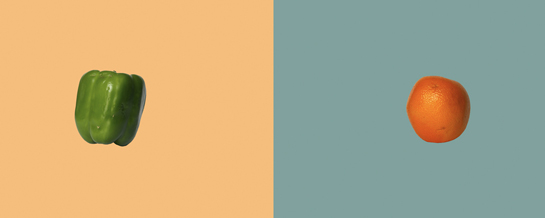
ill: R. Modrak, The Disappearing Orange. How to see your blind spot.
To “see” your blind spot, hold the computer screen at arm’s length. Cover your left eye and focus the right eye on the pepper. Adjust the distance from the screen to your eye until the orange vanishes, indicating that its image has fallen on the optic nerve head of your right eye. Notice that the area where the orange should be is not empty, i.e., white, but filled with the blue surrounding color. This is due to the cerebral cortex’s ability to account for the visual information using nearby sensory data. In ordinary vision, the blindspot goes undetected. This is partly because the blind spot is outside the area of normal visual attention, and partly because of binocular vision and our rapid and frequent eye movement.
Binocular Vision
Ordinarily the brain receives data from both (bi) eyes (ocular) at the same time. The brain combines the two sets of information together to form images. Because the eyes see from slightly different perspectives, the data each sends to the brain is slightly different from the other. The brain uses these small variations to figure out how far away a perceived object is. This is called depth perception. The brain can also use these differences to establish how quickly an object is moving towards or away from a person. This is a type of movement perception.
Simulating loss of binocular vision
If you close one eye and attempt to go through daily activities, you can start to get a sense of what vision is like without binocular images. Enacting a precision task will help you to understand how binocular vision affects depth perception. With your arms fully extended, try pouring liquid into a glass. You may find that, on first attempt, hitting the mark is more difficult than it seems. However, by your second or third try you will probably be successful and, eventually, pouring into the cup becomes as easy as before. This eventual ease is a result of your brain adjusting to the lack of binocular information by turning to other indicators of depth. For example, the size of objects and the way shadows form on them also help to establish an object’s depth.
 photo: R. Modrak, Loss of binocular vision.
photo: R. Modrak, Loss of binocular vision.
The loss of binocular vision can be useful. Closing one eye helps flatten the view in front of you, a phenomenon that is useful in drawing and painting. According to Margaret S. Livingstone, professor of neurobiology of Harvard Medical School, stereoblindness can be an asset. Her research of Rembrandt’s self-portraits, published on September 16, 2004 in The New England Journal of Medicine, indicates that the artist was to some extent, naturally stereoblind. Because his eyes failed to align correctly, he was unable to form binocular vision. This allowed him to more easily see images as two-dimensional for translation onto a flat surface.
Visual White Out: Experiencing The Ganzfeld Effect
The human eye is designed for focus. By directing your eye toward something, you will automatically see in focus, as anything seen straight on falls onto the acute vision of the fovea. Yet the ability to see without focus or without perceiving visual stimuli can be a significant experience that shifts focus from the object of the eye’s vision to the eye and brain themselves.
A Ganzfeld is a visual field with no distinctions. These visual "white outs" exist naturally in locations or situations with few contours: snowy tundras, in mist, fog or blizzard. Fighter pilots must struggle against the potential Ganzfeld from a clear sky by constantly refocusing their vision on clear markers inside the plane. The unusual perceptual experience of the Ganzfeld also allows for exceptional meditative possibilities. On a clear day Tibetan monks attempted to expand consciousness by lying on their backs so that they could see nothing but cloudless sky. After a while, their optic nerve began to stop sending signals to the brain, a meditation phenomenon known as a dharana.
The Reframing Photography book makes analogies between the Ganzfeld and artist Uta Barth's photographs in the essay "Seeing, Perceiving, and Mediating Vision."
The following instructions describe how to perceive a Ganzfeld effect using ping-pong ball halves.
Preparation
Begin with a clean ping-pong ball. There should be no marks or blemishes that your eyes could potentially focus on. Cut the ball as evenly as possible into two halves. Sand the edges of the halved balls with an emery board.
Location
To see a Ganzfeld, choose a quiet space conducive to concentration and a room or location with even lighting and without large areas of shadows. Because simulating a Ganzfeld requires you to keep your eyes open for up to 15 minutes without blinking, you may want to remove contact lenses. You can also stare at the balls before a lamp or up into the sky. Choose a sitting or lying position that will be comfortable for the necessary time, ideally allowing your head to be tilted back to keep the ping-pong balls from popping out of your eyes.
Achieving Ganzfeld
Set a timer for 15 minutes. Place a halved ball over each eye. They must rest over your eyes as tightly as possible without using your hands (your fingers will produce shadows). It helps to “rearrange” the skin above and below the eye-socket by pulling out these areas of skin, placing the halved ball in front of your eyes and letting go of the skin so that it folds over the edges. This secures the balls into place so that you see only white.
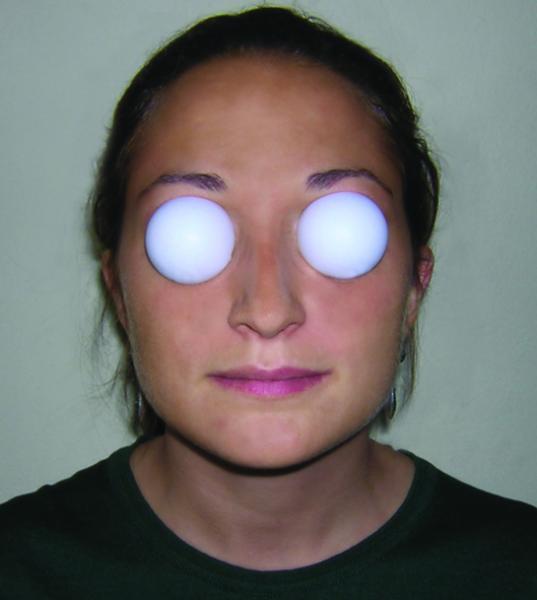 photo: Julia Farina, Staring through ping pong balls to experience a Ganzfeld.
photo: Julia Farina, Staring through ping pong balls to experience a Ganzfeld.
Stare straight ahead without closing your eyes. Do not look down during the experiment. Within a minute of two, the space inside the ball will become unrecognizable as the interior of a ping-pong ball. Soon, it will appear to be a dull white, cloudlike “atmosphere”. After about 7 minutes, you may begin to feel claustrophobic. What had been cloudy will now be more white and uniform in color. You may begin to see thin yellow shapes that move in clusters. Most significantly, you may start to feel a sensation of blindness: you are seeing, yet not seeing anything.
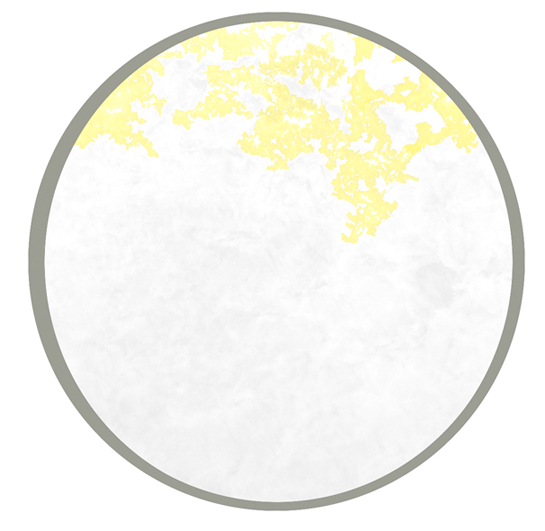
ill: Julia Farina. Image simulating the clusters of yellow shapes you may experience during the experiment. You will not see the phenomena as a circle.
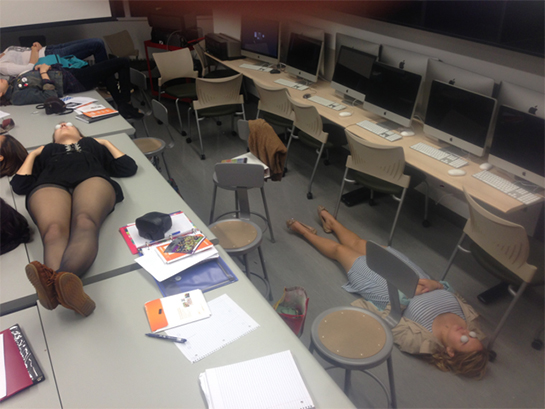
photo: Roger Sayre's class at Pace University stares through ping pong balls to experience a Ganzfeld.
